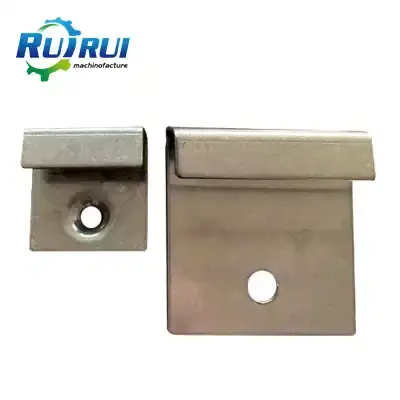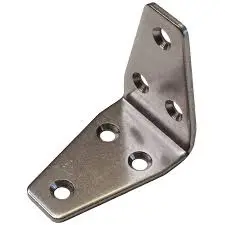How do I Install Stainless Steel Wall Hooks?
2025-04-01 11:06:52
Installing stainless steel wall hooks is a practical solution for creating additional storage and display spaces in homes, offices, and various environments. These versatile and durable fixtures offer a secure and elegant method of hanging items, combining functionality with aesthetic appeal. Whether you're a DIY enthusiast or a professional looking to optimize space utilization, understanding the correct installation process is crucial for achieving optimal performance and longevity of your stainless steel wall hooks.

Understanding Stainless Steel Wall Hooks: Preparation and Essential Tools
Evaluating Your Wall Surface and Hook Requirements
Before embarking on the installation process, conducting a comprehensive assessment of your wall surface and specific hanging needs is paramount. Stainless steel wall hooks are renowned for their exceptional durability and corrosion resistance, making them suitable for diverse environments ranging from kitchens and bathrooms to industrial settings and outdoor spaces. The first critical step involves carefully examining your wall's composition—whether it's drywall, concrete, brick, or wood—as each surface demands a unique approach to ensure secure and stable hook installation.
When selecting stainless steel wall hooks, consider multiple factors beyond mere aesthetic preferences. Assess the weight capacity required for your intended use, the environmental conditions the hooks will be exposed to, and the specific mounting mechanism most appropriate for your wall type. Qingdao RUIRUI Machinery Co., LTD, a leading manufacturer in metal fabrication, offers customizable stainless steel wall hooks with meticulously designed specifications. Their hooks typically feature a square hook edge length of 100mm with a tight tolerance of ±2mm, ensuring precise fit and optimal performance across various applications.
The material composition of these hooks is carefully formulated to deliver exceptional mechanical properties. Primarily composed of high-grade stainless steel, these hooks provide remarkable strength while maintaining remarkable corrosion resistance. This makes them ideal for environments requiring resilient and long-lasting fixing solutions. Available in classic colors like silver and black, with potential for custom color configurations, these hooks can seamlessly integrate into diverse design aesthetics.
Gathering Necessary Installation Tools
Successful installation of stainless steel wall hooks requires a methodical approach and a well-curated set of tools. Essential equipment typically includes:
- Measuring tape for precise positioning
- Pencil for marking installation points
- Level to ensure horizontal alignment
- Electric drill with appropriate drill bits
- Screwdriver set
- Wall anchors compatible with your wall surface
- Safety glasses for personal protection
- Stud finder (recommended for wooden or drywall surfaces)

Professional-grade stainless steel wall hooks often come with comprehensive installation guidelines. The unique square hook design, characterized by optimized four-corner geometry, enables even force distribution and enhanced stability. This innovative structural approach ensures secure attachment and minimizes the risk of hooks becoming loose or detached during use.
Understanding Weight Capacity and Load Limitations
Accurately determining the load-bearing capacity of your stainless steel wall hooks is crucial for safe and effective installation. Factors influencing weight capacity include:
- Hook material thickness (typically 5mm for balanced strength and flexibility)
- Wall surface composition
- Mounting hardware quality
- Installation technique
Manufacturers like RUIRUI recommend consulting product specifications and, when in doubt, selecting hooks with a higher weight rating than your intended load. This conservative approach helps prevent potential structural failures and ensures long-term reliability.
Comprehensive Installation Techniques for Stainless Steel Wall Hooks
Precise Measurement and Marking
Achieving a professional installation begins with meticulous measurement and strategic marking. Start by determining the exact locations where you'll mount your stainless steel wall hooks. Utilize a measuring tape and level to ensure precise alignment, marking points with a pencil that can be easily erased or covered.
For optimal results, consider the following measurement strategies:
- Maintain consistent spacing between hooks
- Align hooks horizontally or according to your specific design requirements
- Account for the weight and dimensions of items to be hung
- Use a stud finder to identify sturdy mounting points in wooden or drywall surfaces
The convenient installation method of modern stainless steel wall hooks allows for quick and straightforward mounting. Simply align the square hook at the appropriate position and apply pressure or use the designated hanging mechanism. This user-friendly approach eliminates the need for complex tools or professional technician assistance, significantly reducing installation time and associated labor costs.
Drilling and Anchor Installation
The drilling process varies significantly depending on your wall surface. For drywall, use a drill bit slightly smaller than your wall anchor to prevent unnecessary wall damage. In concrete or brick surfaces, employ masonry drill bits and corresponding wall anchors designed for heavy-duty applications.
Key drilling considerations include:
- Select drill bits matching anchor and screw dimensions
- Drill perpendicular to the wall surface
- Apply consistent, moderate pressure
- Clear drilling debris before inserting anchors
- Ensure anchors are flush with the wall surface
Stainless steel wall hooks from advanced manufacturers like RUIRUI are engineered with multi-functional applications in mind. Beyond traditional hanging purposes, these hooks can serve as support fixtures, display stands, and versatile connection solutions across various industries and settings.
Securing and Testing Hook Installation
After drilling and inserting anchors, carefully attach your stainless steel wall hooks using appropriate screws. Ensure each screw is tightened uniformly to prevent uneven stress distribution. Once installed, conduct a preliminary stability test by applying gradual pressure and observing the hook's performance.
Recommended testing protocols:
- Apply incremental weight
- Check for any movement or instability
- Verify hook remains firmly attached
- Monitor performance over initial days of use
The high-quality metal materials used in premium stainless steel wall hooks offer exceptional strength and durability. Manufactured through advanced processing technologies like stamping, laser cutting, and precision engineering, these hooks can withstand significant loads while maintaining structural integrity.
Maintenance and Long-Term Care
Cleaning and Preserving Your Stainless Steel Wall Hooks
Regular maintenance ensures the longevity and aesthetic appeal of your stainless steel wall hooks. Despite their inherent corrosion resistance, periodic cleaning and inspection are recommended. Use mild soap solutions and soft cloths to remove dust and prevent potential surface degradation.
Cleaning recommendations:
- Avoid abrasive cleaning materials
- Use pH-neutral cleaning agents
- Dry thoroughly after cleaning
- Inspect for signs of wear or damage periodically
Environmental Considerations
Stainless steel wall hooks excel in diverse environmental conditions. Their composition allows them to resist moisture, temperature variations, and potential chemical exposures. However, extremely aggressive environments might require specialized coatings or specific material grades.
Periodic Performance Evaluation
Conduct routine assessments of your wall hooks' performance. Check for:
- Screw tightness
- Surface corrosion
- Load-bearing capacity maintenance
- Potential wall surface stress
Conclusion
Installing stainless steel wall hooks represents a strategic approach to enhancing spatial organization and functionality. By understanding precise installation techniques, material characteristics, and maintenance protocols, users can maximize the utility and longevity of these versatile fixtures.
Why Choose RUIRUI for Your Stainless Steel Wall Hooks?
At RUIRUI Machinery, we transform innovative technologies into practical solutions. Our commitment to excellence is evident in every product we create. With a global reach spanning over 80 countries and a dedication to continuous improvement, we offer more than just wall hooks—we provide comprehensive engineering solutions tailored to your unique requirements.
Interested in exploring our range of precision-engineered stainless steel wall hooks? Connect with our expert team today and experience the RUIRUI difference. Email us at info@qdkshd.com to discuss your specific needs and discover how we can elevate your project's potential.
References
1. Johnson, M. (2022). Advanced Metal Fabrication Techniques in Modern Manufacturing. Engineering Press.
2. Williams, S. (2021). Corrosion Resistance of Stainless Steel Alloys. Materials Science Review.
3. Rodriguez, P. (2020). Innovative Mounting Solutions in Construction Engineering. Architectural Design Journal.
4. Chen, L. (2019). Load-Bearing Characteristics of Metal Fixtures. Structural Engineering Quarterly.
5. Thompson, R. (2018). Surface Treatment Technologies in Metal Manufacturing. Industrial Materials Research.
6. Garcia, A. (2017). Precision Engineering in Custom Metal Components. Manufacturing Innovation Review.
Send Inquiry
You may like
